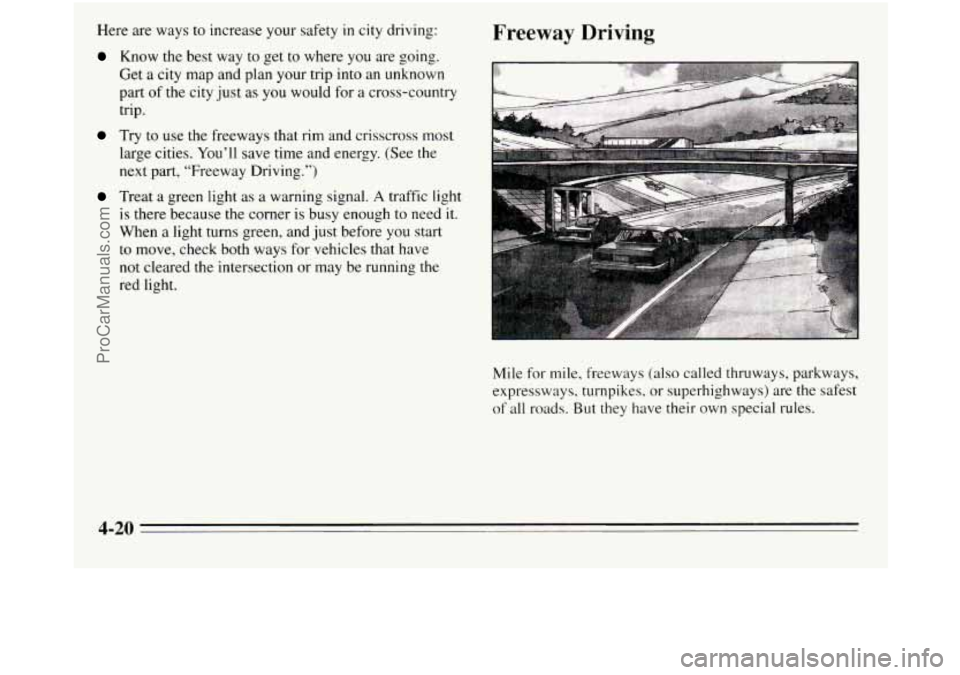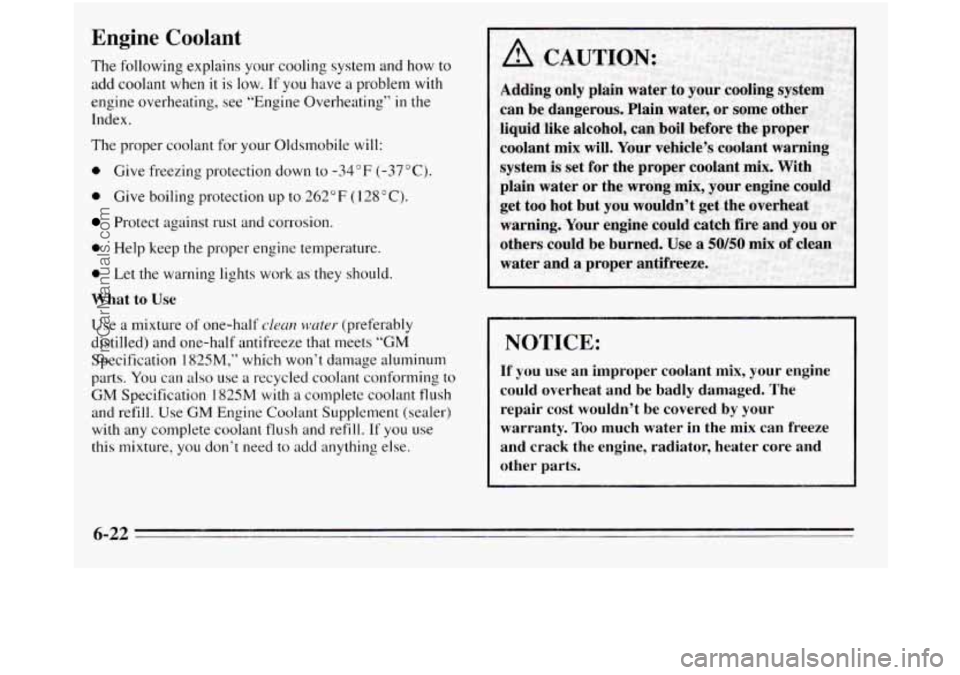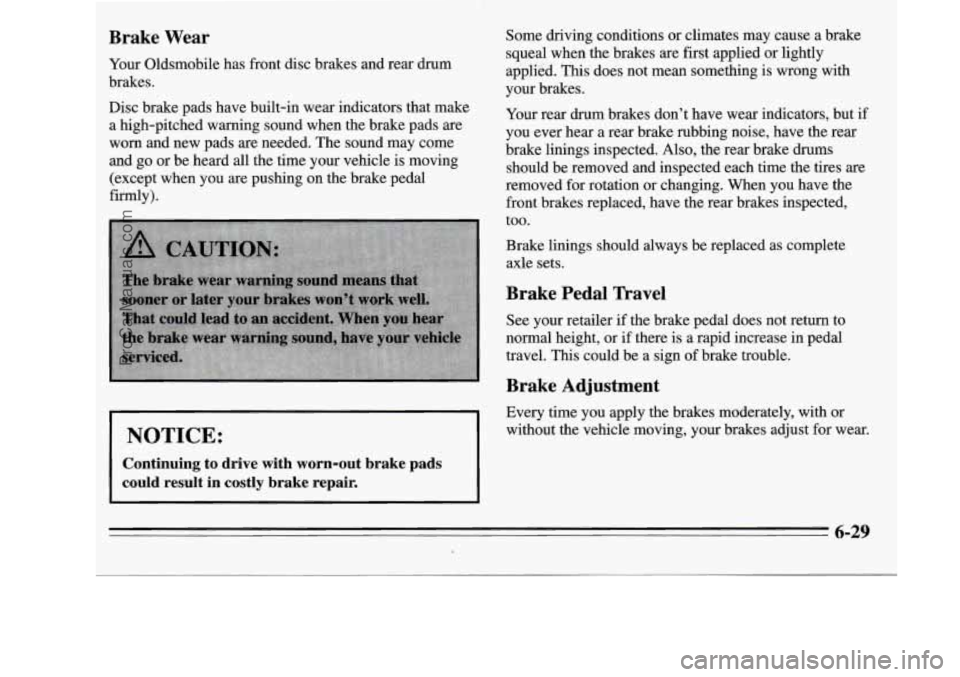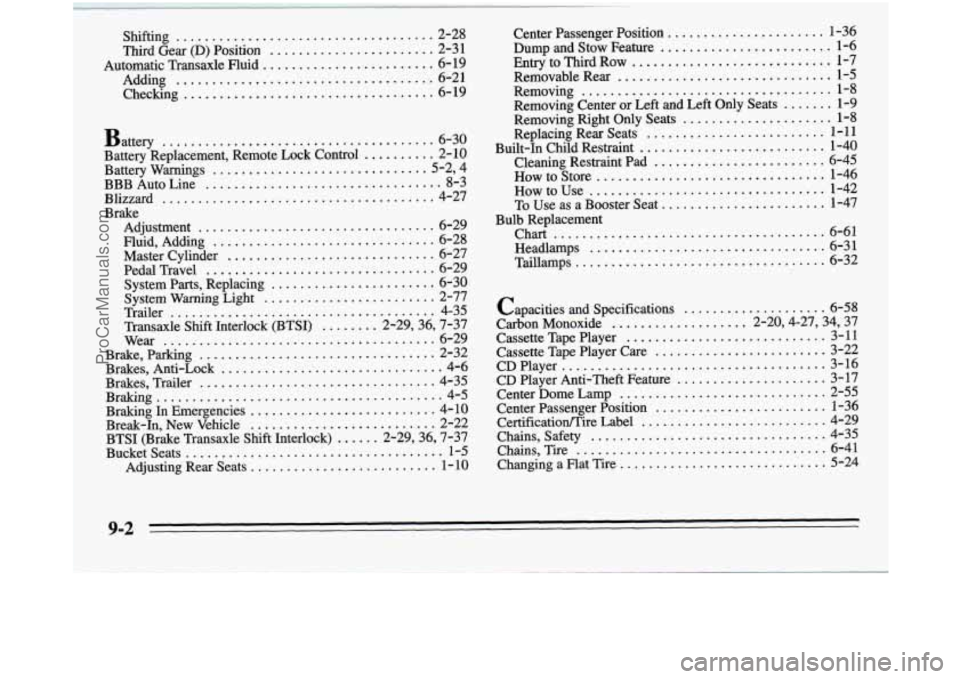1995 OLDSMOBILE SILHOUETTE warning light
[x] Cancel search: warning lightPage 191 of 390

Traction Control System
(Option:
3800 V6 Engine)
Your vehicle may have a traction control system that
limits wheel spin. This is especially useful in slippery
road conditions. The system operates only if it senses
that one or both of the front wheels are spinning or
beginning to lose traction.
When this happens, the system works the front brakes
and reduces engine power to limit wheel spin.
The LOW TRACTION light will come on when your
traction control system is limiting wheel spin. See
“Low Traction Light” in the Index. You may feel the
system working, or you may notice some noise, but this
is normal.
If your vehicle is in cruise control when the traction
control system begins to limit wheel spin, the cruise
control will automatically disengage. When road
conditions allow you
to safely use it again, you may
re-engage the cruise control. (See “Cruise Control” in
the Index.)
TCS
The TCS warning light will come on to let you know if
there’s a problem with your traction control system.
See “Traction Control System Warning Light’’ in the
Index. When this warning light is on, the system will not
limit wheel spin. Adjust your driving accordingly.
4-9
ProCarManuals.com
Page 202 of 390

Here are ways to increase your safety in city driving:
Know the best way to get to where you are going.
Get
a city map and plan your trip into an unknown
part
of the city just as you would for a cross-country
trip.
Freeway Driving
Try to use the freeways that rim and crisscross most
large cities. You’ll save time and energy. (See the
next part, “Freeway Driving.”)
Treat a green light as a warning signal. A traffic light
is there because the corner is busy enough
to need it.
When a light turns green, and just before you start
to move, check both ways for vehicles that have
not cleared the intersection or may be running the
red light.
Mile for
mile, freeways (also called thruways, parkways,
expressways, turnpikes. or superhighways) are the safest
of all roads. But they have their own special rules.
4-20
ProCarManuals.com
Page 207 of 390

Include an ice scraper, a small brush or broom, a supply
of windshield washer fluid, a rag, some winter outer
clothing, a small shovel,
a flashlight, a red cloth, and a
couple of reflective warning triangles. And, if you will
be driving under severe conditions, include a small bag
of sand, a piece
of old carpet or a couple of burlap bags
to help provide traction. Be sure you properly secure
these items in your vehicle.
Driving on Snow or Ice
Most of the time, those places where your tires meet the
road probably have good traction.
However,
if there is snow or ice between your tires and
the road, you can have
a very slippery situation. You’ll
have a lot less traction or “grip” and will need to be very
careful.
What’s the worst time for this? “Wet ice.” Very cold
snow or ice can be slick and hard to drive on. But wet
ice can be even more trouble because it may offer the
least traction of all. You can get “wet ice” when it’s
about freezing
(32 OF; 0” C) and freezing rain begins to
fall. Try
to avoid driving on wet ice until salt and sand
crews can get there.
4-25
ProCarManuals.com
Page 282 of 390

Engine Coolant
The following explains your cooling system and how to
add coolant when it is low.
If you have a problem with
engine overheating, see “Engine Overheating”
in the
Index.
The proper coolant for your Oldsmobile
will:
0 Give freezing protection down to -34°F (-37°C).
0 Give boiling protection up to 262 OF ( 128 ” C).
Protect against rust and corrosion.
0 Help keep the proper engine temperature.
0 Let the warning lights work as they should.
What to Use
Use a mixture of one-half clean water (preferably
distilled)
and one-half antifreeze that meets “GM
Specification
1825M,” which won’t damage aluminum
parts. You can also use a recycled coolant conforming to
GM Specification 1825M with a complete coolant flush
and refill. Use GM Engine Coolant Supplement (sealer)
with any complete coolant flush and refill.
If you use
this mixture,
you don’t need to add anything else.
NOTICE:
If you use an improper coolant mix, your engine
could overheat and be badly damaged.
The
repair cost wouldn’t be covered by your
warranty.
Too much water in the mix can freeze
and crack the engine, radiator, heater core and
other parts.
6-22
ProCarManuals.com
Page 288 of 390

should have your brake system fixed, since a leak means
that sooner or later your brakes won’t work well, or
won’t work at all.
So, it isn’t a good idea to “top off’
your brake fluid. Adding brake fluid won’t correct a
leak. If you add fluid when your linings are worn, then
you’ll have too much fluid when you get new brake
linings. You should add (or remove) brake fluid, as
necessary, only when work is done on the brake
hydraulic system.
When your brake fluid falls to a low level, your brake
warning light will come on. See “Brake System Warning
Light” in the Index.
~~
~~~ ~~~ ~
What to Add
The brake fluid reservoir is located to the left of the
windshield washer fluid reservoir, at the back of the
engine compartment.
When you
do need brake fluid, use only DOT-3 brake
fluid
-- such as Delco Supreme 11 @ (GM Part
No. 1052535). Use new brake fluid from a sealed
container only, and always clean the brake fluid
reservoir cap before removin,g it.
-
NOTICE:
0 Don’t let someone put in the wrong kind of
fluid. For example, just a few drops of
mineral-based oil, such
as engine oil, in
your brake system can damage brake
system parts
so badly that they’ll have to be
replaced.
0 Brake fluid can damage paint, so be careful
not to spill brake fluid on your vehicle.
If
you do, wash it off immediately. See
“Appearance Care” in the Index.
6-28
ProCarManuals.com
Page 289 of 390

Brake Wear
Your Oldsmobile has front disc brakes and rear drum
brakes.
Disc brake pads have built-in wear indicators that make
a high-pitched warning sound when the brake pads are
worn and new pads are needed. The sound may come
and go or be heard
all the time your vehicle is moving
(except when you are pushing on the brake pedal
firmly).
NOTICE:
Continuing to drive with worn-out brake pads
could result in costly brake repair.
Some driving conditions or climates may cause a brake
squeal when the brakes are first applied or lightly
applied.
This does not mean something is wrong with
your brakes.
Your rear drum brakes don’t have wear indicators, but
if
you ever hear a rear brake rubbing noise, have the rear
brake linings inspected. Also, the rear brake drums
should be removed and inspected each time the tires are
removed for rotation or changing. When you have the
front brakes replaced, have the rear brakes inspected,
too.
Brake linings should always be replaced as complete
axle sets.
Brake Pedal Travel
See your retailer if the brake pedal does not return to
normal height, or if there is a rapid increase in pedal
travel.
This could be a sign of brake trouble.
Brake Adjustment
Every time you apply the brakes moderately, with or
without the vehicle moving, your brakes adjust for wear.
6-29
ProCarManuals.com
Page 377 of 390

Section 9 Index
Accessory Power Outlet ......................... 2-57
Adding Automatic Transaxle Fluid
..................... 6-2 1
BrakeFluid ................................. 6-28
Electrical Equipment
............... 2.25.3.21. 6.51
Engine Coolant
.............................. 6-23
Engineoil
.................................. 6-12
Power Steering Fluid
......................... 6-26
SoundEquipment
............................ 3-21
Windshield Washer Fluid
................. 2.43. 6-26
AirBag
....................................... 1-26
How Does
it Restrain ......................... 1-29
How
it Works ............................... 1-28
Location
................................... 1-28
Readiness Light
........................ 1.27. 2.76
What Makes it Inflate
......................... 1-29
What Will You See After it Inflates
.............. 1-30
When Should
it Inflate ........................ 1-29
AirClealler
.................................... 6-17
Airconditioner
................................. 3-2
AirInflator
.................................... 2-63
Alignment and Balance. Tires
..................... 6-40
Aluminum Wheels. Cleaning
...................... 6-48
Servicing
................................... 1-31 Antenna.
Integrated Roof
......................... 3-23
Anti-Lock
..................................... 4-6
Anti-Lock Brake (ABS) Junction Block Fuse ......... 6-56
Anti-Lock Brake System Warning Light
......... 2.78. 4.7
Anti-Lock Brakes
............................... 4-6
Anti-Theft Feature. CD Player
.................... 3-17
Antifreeze
..................................... 6-22
Adding
.................................... 6-23
Checking
................................... 6-23
Appearance Care
............................... 6-42
Appearance Care and Materials
.................... 6-50
Ashtrays
................................... 2.65. 66
Audio Systems
.................................. 3-8
Auto Down Window Feature
...................... 2-39
Automatic Door Locks
............................ 2-5
Automatic Overdrive Position
..................... 2-30
Automatic Transaxle
............................ 2-28
Automatic Overdrive Position
.................. 2-30
First Gear (1) Position
........................ 2-32
Neutral
(N) Position .......................... 2-30
Park (P) Position
............................. 2-29
Reverse (R) Position
.......................... 2-29
Second Gear
(2) Position ...................... 2-31
Audio
System. Steering Wheel Touch Controls
....... 3-20
9-1
ProCarManuals.com
Page 378 of 390

Battery ...................................... 6-30
Battery Replacement. Remote Lock Control .......... 2-10
BBB Auto Line ................................. 8-3
Adjustment ................................. 6-29
Fluid, Adding ............................... 6-28
Master Cylinder ............................. 6-27
Pedal Travel ................................ 6-29
System Parts. Replacing ....................... 6-30
System Warning Light ........................ 2-77
BatteryWarnings ..............................5-2. 4
Blizzard ...................................... 4-27
Brake Trailer
..................................... 4-35
Transaxle Shift Interlock (BTSI) ........ 2-29.36. 7-37
Wear ...................................... 6-29
Brake. Parking ................................. 2-32
Brakes. Trailer .................................. 4-35
Brakes. Anti-Lock ............................... 4-6
Braking ........................................ 4-5
Braking In Emergencies .......................... 4-10
Break-In. New Vehicle .......................... 2-22
BTSI (Brake Transaxle Shift Interlock) ...... 2-29.36. 7-37
Bucketseats .................................... 1-5
Adjusting Rear Seats .......................... 1- 10
Capacities and Specifications ..................... 6-58
CarbonMonoxide ................... 2.20.4.27.34. 37
Cassette Tape Player ............................ 3-11
Cassette Tape Player Care ........................ 3-22
CD Player Anti-Theft Feature ..................... 3-17
Center Dome Lamp ............................. 2-55
Center Passenger Position ........................ 1-36
Certificatioflire Label .......................... 4-29
Chains, Safety ................................. 4-35
Changing a Flat Tire ............................. 5-24
CDPlayer ..................................... 3-16
Chains, Tire ................................... 6-41
9-2
ProCarManuals.com